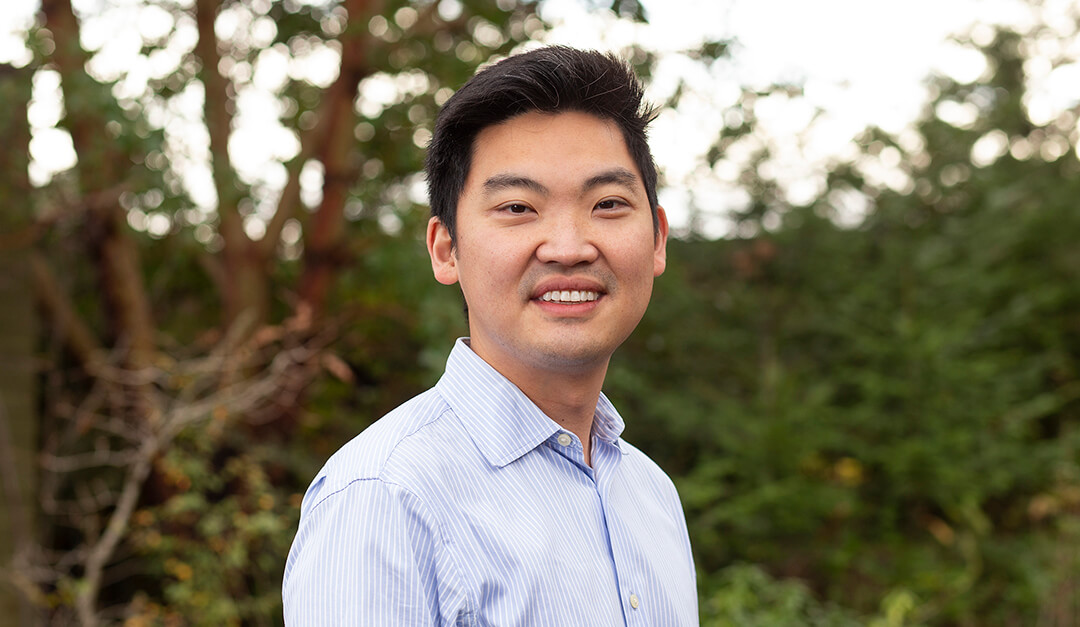By Jon Chabun. Photo by UVic Photo Services
It was unusual for an academic professor to come up with the first FDA emergency use authorized COVID-19 therapeutic. It was also unusual for the same professor to launch a company with a $15 billion initial public offering, the most ever for a Canadian biotech startup.
How was this professor, Carl Hansen who was then at UBC, able to develop a COVID therapeutic quicker than the pharmaceutical giants? The circumstances piqued the interest of Andrew Park, assistant professor at the Gustavson School of Business, and his colleagues.
Their recent research paper*, published in Nature Nanotechnology, is titled “Rapid response through the entrepreneurial capabilities of academic scientists.” The paper explores the decisions that led to this professor’s surprising success with his company, AbCellera, and offers a possible way forward for others.
“We explored in-depth the traits of this particular entrepreneur that enabled him to rapidly respond to COVID,” says Park. “A lot of the big companies, they tried to do it and they couldn’t succeed.”
For Park, the goal of the research was to aid professors with great inventions in becoming entrepreneurs. In the pharmaceutical industry, there is one common way to proceed.
“Many drug companies follow the blockbuster drug model,” says Park. “If I’m trying to create a new drug, I raise billions of dollars and I use it all to come up with a drug. If I am successful, I become a multi-billion-dollar company. But if I don’t find a new drug, the company may fold and the investors lose all their money. This is often how drug companies usually work. It’s all or nothing.”
Park and his co-authors determined that Hansen did things differently by getting some early money coming in to support his long-term goals.
“He built a software platform that would help other drug companies simulate parts of their drug discovery process,” says Park. “He licensed this out to these companies and made money to fund his more ambitious project of antibody therapeutic development.”
A professor might have a great invention but they might not have an idea of who’s going to buy it or what product it can become.
“You can have the most amazing technology but if you don’t find a good market for it, the technology is commercially worthless,” says Park.
Hansen was able to find a market fit.
“He had something called microfluidic technology that could be used in the antibody market,” says Park. “Whatever a new disease comes about, this particular technology could be useful whenever you need to discover antibodies for it. Since he had done so much work to develop his antibody capabilities, when COVID came, he’d already built the expertise to be able to rapidly produce a drug for it.”
Park says that his research team’s findings don’t necessarily apply for every type of entrepreneur.
“Our research is useful for academic scientists,” he says. “For academic scientists who have big ambitions for coming up with, let’s say, a new cancer drug, our research might be quite useful for them to start taking some steps now while they’re still in academia.”
Hansen’s success story was unusual. It was also unusual for business research about his story to find its way into an influential science journal like Nature Nanotechnology.
“This Nature article is a case study on a biotech company, who used some computer science fundamentals to be able to become successful in their business,” Park says.
Park’s own background reflects an intersection of business and technology.
The son of a software engineer, he started programming computers at the age of five. By seven years old, he was programming simple video games where a little stick figure man would push a ball across the screen. In high school, he used his programming knowledge to create ‘web scrapers’ that would collect information from the internet. He later wrote a script to select all his university courses and avoid waitlists. When interviewing for the job at Gustavson, he even did a programming demo.
After first getting an undergraduate degree in molecular biology, he started a health tech startup based out of Seattle. He grew that company for seven years before selling it to a large investment group. That scientific background lets him comfortably write on topics such as the pharmaceutical industry.
Park says that the university environment can pose a challenge to entrepreneurial professors. Universities evaluate professors based on the quality of their research and their teaching. Professors don’t always get credit for being an entrepreneur.
“If you start a company, it often has to be a side hustle on evenings and weekends, which doesn’t do the technology justice. If you want to be an entrepreneur, you need to go all in,” he says.
He hopes his research can provide a roadmap for academic scientists looking to start their own companies.
Park, A., Goudarzi, A., Yaghmaie, P., Thomas, J., & Maine, E. (2022). Rapid Response Through the Entrepreneurial Capabilities of Academic Scientists. Nature Nanotechnology. https://www.nature.com/articles/s41565-022-01103-6


